Posts by Dr. Lelan Olsen
Dr. Olsen’s Breed Spotlight: The Irish Wolfhound
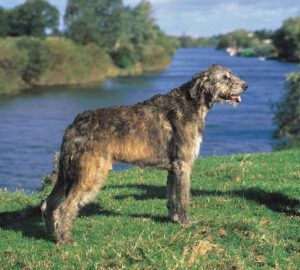 For this next breed spotlight, I will be introducing you to the Irish wolfhound, likely for the first time. This dog is calm, dignified, and the tallest breed of dog (sorry Great Danes). Early ancestors of Irish wolfhounds were fearless, big-game hunters who could dispatch a wolf in single combat. Today, they are the most serene and agreeable of companions.
For this next breed spotlight, I will be introducing you to the Irish wolfhound, likely for the first time. This dog is calm, dignified, and the tallest breed of dog (sorry Great Danes). Early ancestors of Irish wolfhounds were fearless, big-game hunters who could dispatch a wolf in single combat. Today, they are the most serene and agreeable of companions.
The amiable Irish Wolfhound is an immense and muscular hound. They are built along classic Greyhound lines, capable of great speeds at a gallop. A male might stand nearly three feet at the shoulder and can weigh up to 180 pounds. Females will run smaller but are still a very large dog. They have a rough and hard coat that can come in many colors. They can be white, gray, brindle, red, black, and fawn. Irish wolfhounds are way too serene to be fierce guard dogs, but the mere sight of the size of these dogs are enough to deter intruders. Irish wolfhounds are characteristically patient with kids, but their size does require supervision when they are around small children.
The history of this wolfhound goes back to the breeding of indigenous large dogs of Britain to the Middle Eastern coursing hounds that were bartered around the known world in the earliest days of international trade. By the time the Roman Empire had gained a toehold in the British Isles, the giant hounds of Ireland were already long established. In the year 391, the Roman consul received a gift of seven of these hounds that “all Rome viewed with wonder”. These majestic hunters, whose motto was “gentle when stroked, fierce when provoked”, were used on such quarry as the now-extinct Irish elk, a massive, ferocious beast said to stand six feet at the shoulder. In 15th-century Ireland, wolves were overrunning the countryside. The Irish hounds, already renowned big-game hunters, began to specialize on wolves. By the late 1700s, when wolves and other big-game animals of Ireland were hunted to extinctions, Irish wolfhounds lost their job and nearly went extinct themselves. This is a case of a breed doing its job too well for its own good. In 1862, British army captain George Augustus Graham began scouring the country for remaining specimens of Ireland’s national hound. Graham made it his life’s work to protect, standardize, and promote the breed. Today, his name is still spoken with reverence wherever Irish wolfhound fanciers gather.
The coats of Irish wolfhounds have two layers; the outer being harsh and wiry with the under being very soft. They shed throughout the year, but not in an excessive amount. Unlike many other double-coated breeds, Irish wolfhounds don’t “blow out” their coats during an annual or semi-annual shedding season. Irish wolfhounds retain a strong instinct to hunt and chase prey, so they should only be allowed off the leash in areas that are securely fenced. As adults, Irish wolfhounds can become couch potatoes if allowed to, but regular exercise like long walks and play sessions help keep them physically and mentally healthy. A home with a large, fenced area is necessary to provide the environment needed for this breed to thrive. The breed can also exercise mind and body by participating in canine sports like tracking, agility, and lure coursing.
These gentle giants are sure are a breed with a rich history. Their ancestors’ traits reveal themselves with their passion for hunting and need for mental and physical exercise. Generally, these dogs make excellent companions for anyone with enough land to satisfy their need to run. With any questions, please feel free to contact Dr. Olsen at 618-656-5868.
What to Do to Keep Your Dog Cool This Summer – and What NOT to Do
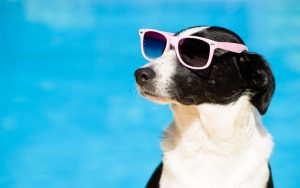 Keeping your dog cool during the summertime is difficult yet very important. The most important thing to remember is having plenty of fresh, cold water available for your pup. Whether it is just for playing in the back yard or going on a long hike, be sure to keep fresh, cold water available and accessible for them. When you are out on the go, bring a collapsible water bowl or a squirt bottle. Give your dog small amounts of water every 15 to 20 minutes. Be sure to have enough cool water with you to last the entire time you’re gone. If your dog starts panting excessively, get your dog shade and more water right away.
Keeping your dog cool during the summertime is difficult yet very important. The most important thing to remember is having plenty of fresh, cold water available for your pup. Whether it is just for playing in the back yard or going on a long hike, be sure to keep fresh, cold water available and accessible for them. When you are out on the go, bring a collapsible water bowl or a squirt bottle. Give your dog small amounts of water every 15 to 20 minutes. Be sure to have enough cool water with you to last the entire time you’re gone. If your dog starts panting excessively, get your dog shade and more water right away.
Similarly, an easy way to keep your dog cool while spending summer outside is to play in the water. A wet dog is a cool dog. You can play with your pooch in sprinklers, pools, and lakes. Swimming can help lower your dog’s body temperature and help them stay cool while having fun.
While there are things you can do to keep them cool, there are also things you should NEVER do. The biggest rule is to never leave your dog in a parked car, even with the windows cracked. Even on milder days, temperatures inside your car can quickly rise to dangerous and life-threatening levels. The CDC says that cars parked in direct sunlight can reach internal temperatures up to 131ºF-172ºF when it is 80ºF-100ºF outside. These temperatures are extremely dangerous, and your dog should never be subjected to it.
Also, avoid being outside with your dog during the midday heat. It is ok to be outside with your dog on mild, overcast days with low humidity. However, if it is sunny, 80º and high humidity, it is better to avoid the midday heat. On days like these, go early in the morning or later in the evening when it is not as hot. It is important to remember the danger of asphalt during the summer. Asphalt can get extremely hot in direct sun. Put your hand on the pavement to test the temperature. If it is too hot for your hand, it is too hot for your dog. You can also pour some water on the pavement. If it steams, it is way too hot. You can buy booties for your dog, so their feet are not on pavement, but it is easiest to avoid it all together. It is best to find trails. Because they aren’t hard surfaces and typically shaded, they’re less likely to cause injury.
During the summer, it is very important to know the signs of heatstroke in dogs. Pay attention to your dog’s behavior, body language, and more. Symptoms of heatstroke include excessive panting, excessive salivating, obvious discomfort, vomiting, diarrhea, disorientation, and seizures. If you notice any of these symptoms, get your dog to a cooler environment as soon as possible and calling your veterinarian for further instructions. You can use a thermometer to check their body temperature. If it is above 104º, it is time to get them out of the sun and decrease the level of activity. 104º is not dangerous, but it is the threshold to where it could become dangerous. When your dog’s temperature stays elevated, even after stopping activity and getting out of the heat, this is a sign that you need to intervene and call your vet. Please feel free to contact Dr. Olsen at Olsen Veterinary Clinic at 618-656-5868 with any questions.
Cat Adoption Checklist
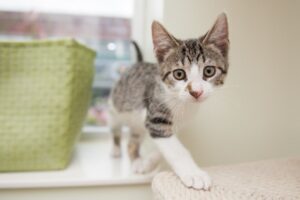 After deciding to adopt a cat, there is plenty to be done. It can seem overwhelming, but hopefully this quick checklist will provide you with information on how to best prepare for your new furry friend.
After deciding to adopt a cat, there is plenty to be done. It can seem overwhelming, but hopefully this quick checklist will provide you with information on how to best prepare for your new furry friend.
Prepare a cat room or area.
One of the most important things your cat needs is a quiet, cozy, and secluded space that your cat can consider their own. It can be a spare bedroom or a corner of your living room. This will make sure your cat becomes familiar with their space before exploring the rest of their home.
Remove any hazards.
Look for strangle hazards such as the cords to blinds, tassels, and drapes. Cats are notoriously curious, so they will play with anything they can find. Similarly, make sure any other hazards like cords, rubber bands, or other small items are not accessible to your cat. Hide any chemicals so your cat is not tempted to drink or lick them. Lastly, remove any toxic plants.
Provide access to a high spot.
Buy having a high spot, cats can view their surroundings with ease. A simple cardboard box in a high place will do the trick but you can buy fancier products. One example is a cat hammock that attaches to your window with suction cups.
Provide your cat plenty of hiding spots.
All cats enjoy hiding places. This can be in a cardboard box, under furniture, or even a cat tree. Do not be alarmed if your cat hides for most of the day when you first bring them home. Just make sure they are eating, drinking, and defecating regularly and give them time to adjust to their new home.
Buy cat products.
This involves a food bowl, water bowl, cat food, a soft bed, a litter box, cat litter, a scratching post, a brush, a cat carrier, and stimulating cat toys.
When adopting a cat, the prep work can seem overwhelming. Hopefully this checklist provided some clarity on what you can do to provide the best home for your new furry friend. As always, feel free to contact Dr. Olsen with any questions at 618-656-5868.
5 Reasons To Microchip Your Dog
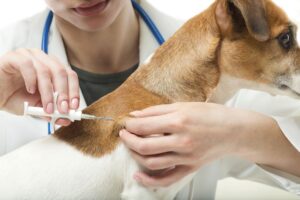 Microchipping your dog could seem useless and unimportant. In reality, it is something that is extremely important for your dog’s life in case anything bad happens. Microchipping involves implanting a rice-sized chip between your pet’s shoulder blades. It is highly recommended by veterinarians, breeders, and animal-rescue organizations. In some countries, it is even law to have your dog microchipped. If the recommendation by your vet is not enough reasoning for you to have your dog microchipped, here are five reasons to stay prepared with a microchip.
Microchipping your dog could seem useless and unimportant. In reality, it is something that is extremely important for your dog’s life in case anything bad happens. Microchipping involves implanting a rice-sized chip between your pet’s shoulder blades. It is highly recommended by veterinarians, breeders, and animal-rescue organizations. In some countries, it is even law to have your dog microchipped. If the recommendation by your vet is not enough reasoning for you to have your dog microchipped, here are five reasons to stay prepared with a microchip.
In case your dog ever gets lost. It may be easy to think that it will never happen to your dog. However, AKC Reunite reports that one in three dogs will go missing at some point in their lifetime. A collar is beneficial in protecting your dog if they get lost, but collars can easily break, fall off, or be removed. A microchip, however, is a reliable and safe way to get the owner’s contact information as well as vital medical information to increase the odds that they will be returned to the owner.
If your dog gets stolen. If a dog is ever stolen, it can be hard to ensure the identity of one dog to another dog, especially if steps have been made to change their appearance. A microchip will clear up any dispute with a quick scan, proving who is the correct owner.
If something happens to you. If you get in an accident and are with your pet, records can be obtained from the pet’s microchip, allowing the authorities to get in contact with your family. Microchips provide identification for not only your pet, but you as well.
Microchips are getting more tech-savvy. Some microchip manufacturers are implementing functionality for smart homes. For example, some chips can communicate with doggie doors to let your dog and your dog only inside or out to prevent unwanted critters from getting in. Other manufacturers also offer lost pet alerting services and even travel assistance for people who like to take their pets along on vacations.
Microchips last a lifetime. Unlike collars, microchips last forever and can’t be lost. Once implanted, you don’t have to worry about them. It can be worthwhile to ask your vet to scan it at a visit to make sure that it is not malfunctioning. It is a simple step that you can take to protect you and your dog.
Microchipping is a fairly inexpensive way to protect you and your family. Especially when you consider the cost of losing your family pet. For this and any other questions or concern for your pet, don’t hesitate to contact us today!
Can Dogs and Cats Cohabitate?
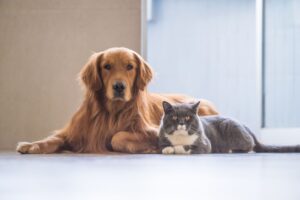 Many pet parents do not have just one pet. They have multiple cats, multiple dogs, etc. A big question for many pet parents is whether a dog and cat can live together peacefully. Canines and felines are not known to be great friends, but they are able to learn to tolerate each other and even develop a strong, loving bond. Acquiring this requires some careful preparation, but it is possible to develop a union between your cats and dogs.
Many pet parents do not have just one pet. They have multiple cats, multiple dogs, etc. A big question for many pet parents is whether a dog and cat can live together peacefully. Canines and felines are not known to be great friends, but they are able to learn to tolerate each other and even develop a strong, loving bond. Acquiring this requires some careful preparation, but it is possible to develop a union between your cats and dogs.
Dogs and cats are not destined to be foes. A nurturing friendship between your dog and cat is possible, regardless of what myths society has adopted. If dogs and cats are property socialized, they are able to become friends. It may just take some time for your dog and cat who have never met to acclimate to each other. It is important to note that both animals are territorial and have different communication methods that can impact their behavior. For example, a dog wags its tail to show happiness and eagerness to play. On the other hand, cats lash their tail to indicate anger and displeasure. It is easiest for animals to cohabitate if they are both raised together from a young age. Similarly, when distributing treats, attention, or praise, be sure to distribute them equally in order to prevent jealousy.
It is not always easy to introduce your cat or dog to your resident pet, it can take several weeks or even months. Be patient but realize that whether or not your pet gets along will depend as much on their personalities as on how you approach the process. Follow these initial steps to help accommodate your pets as much as possible.
First, choose a proper location for the first meeting of your pets. If your pet is a long-term resident of a specific room, they may act territorial and take offence when the new animal is on its turf. Start with a neutral ground to the both of them. Second, keep the animals separated initially. Across several days, rotate which animal has freedom and which is confined to allow each pet plenty of time to investigate the other animal’s scent. Next, make face-to-face introductions. Allow both pets to be in the same room at the same time, but keep the dog leashed. Continue with this type of interaction until your cat stays calm and ignores the dog, and vice versa. Lastly, proceed with caution. Once the pets consistently get along during leashed visits, they are ready for the next step of removing the leash. Do not leave them alone with each other until you are sure that they are fully comfortable with each other.
Properly introducing your cats and dogs to live together can be extremely influential in a peaceful cohabitation between your dog and cat. Be sure to remain watchful and alert while the meeting process is occurring. With a little patience, your pets will successfully be cohabitating happily in no time.
As always, we are here to help with anything you need for your furry family member. Contact us today with your questions!
What You Need To Know About Pet Poisons
 No pet owner wants to hurt their furry friend, but sometimes it is inevitable. Accidental poisonings can be prevented with simple switches in your home. One of the easiest ways to prevent an accidental poisoning is to watch what you plant in and around your house. While plants provide clean air for you home, they can also be really dangerous for pets based on what types of plants they are. Plants that aren’t toxic to humans like the hibiscus, those in the Easter lily family, mistletoe, and Dieffenbachia can cause medical problems in pets. Issues such as renal failure, irregular heartbeats, cardiac shock, or even death. Other examples of toxic plants include azalea, oleander, castor bean, sago palm, rhododendron, and Japanese yew. If you have these plants and cannot stand to give them up, put them up high in an unreachable location where your animal cannot chew or dig them up
No pet owner wants to hurt their furry friend, but sometimes it is inevitable. Accidental poisonings can be prevented with simple switches in your home. One of the easiest ways to prevent an accidental poisoning is to watch what you plant in and around your house. While plants provide clean air for you home, they can also be really dangerous for pets based on what types of plants they are. Plants that aren’t toxic to humans like the hibiscus, those in the Easter lily family, mistletoe, and Dieffenbachia can cause medical problems in pets. Issues such as renal failure, irregular heartbeats, cardiac shock, or even death. Other examples of toxic plants include azalea, oleander, castor bean, sago palm, rhododendron, and Japanese yew. If you have these plants and cannot stand to give them up, put them up high in an unreachable location where your animal cannot chew or dig them up
Your cat may love to snack on some grass outside, but this grass can be loaded up with deadly fertilizers and pesticides. Instead, you could make an indoor mini lawn for your cat. Mini lawns provide a safe, edible source of greenery. Special feline gardens are available commercially or you can start your own kitty garden using a bowl, soil, and grass seed. You could also grow catnip for you cat, but make sure to monitor how much your cat chews. While catnip is not generally toxic for cats, too much of the plant can overstimulate your cat’s central nervous system and cause a cat to injure themselves.
If you find that your pet was chewing on a plant, immediately remove the plant from their mouth and rinse their mouth gently with water. Identify which plant your pet was eating and call the poison center or your veterinarian. Be sure to watch for excessive or foamy salivation and changes in the skin around the mouth, eyes, or paws.
Another common cause of accidental poisonings is giving your pet something intended for a human. This could include people food, chemicals, or even medications. People often make the mistake of thinking that people food is ok for pets. Sometimes it is and sometimes it is not. Be sure to avoid milk, bones, chocolate, onions, rich and fatty foods, grapes, raisins, coffee, nicotine, and alcoholic beverages.
Like a child, one should poison-proof their house. Be sure to keep the cleaning products in a high, closed cabinet. There should be nothing below counter level because liquid drain cleaners, as well as tub and tile cleaners, can be lethal. Be sure to take precautions in the garage as well. Insecticides and auto care liquids need to be store high off of the ground to keep your pets from getting into them. Accidental chemical poisonings can even be made in giving medication. Avoid this by reading the label. For example, be sure to read the labels of flea control for your pets because the chemicals in dog flea agents are lethal for cats. Be sure to read the label directions and amounts carefully.
Some pet owners think that human medication will work for pets. This is incorrect. Never give your pet a human medication without consulting with your veterinarian. Even something as simple as aspirin can be lethal to your pet. Products such as acetaminophen and any aspirin product can cause stomach bleeding. Products like birth control and vitamins can also cause internal bleeding.
Cats tend to be attracted to unusual flavors. Be sure to keep things like the calamine lotion, diaper cream, sunblock, etc. away. These products contain an acid related to aspirin in them and will be toxic if ingested. Overall, small actions you take can help prevent the poisonings of your pets and keep them health. If you have any questions, feel free to contact Dr. Olsen at Olsen Veterinary Clinic at 618-656-5868.
9 Dog Training Tips
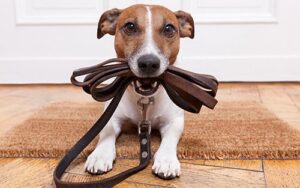 Every puppy needs training, and sometimes it is hard to know what is best for your dog! With these tips, training can be fun and efficient!
Every puppy needs training, and sometimes it is hard to know what is best for your dog! With these tips, training can be fun and efficient!
1. Choose your Dog’s Name!
While this step may not seem to affect training, short names with strong endings are easier for your dog to pick up while training. These include Jasper, Jack, and Ginger. If your dog is an older dog when you begin training, they are probably used to their name. This doesn’t mean that you can’t change it. If your new pal is coming out of an abusive situation, a new name may even represent a fresh start. Dogs are very adaptable to new situations. If you decide to give them a new name, use it consistently and soon enough your pup will respond to it. Whatever you choose to name your dog, be sure to associate it with fun, pleasant experiences as much as possible, rather than negative ones. Ideally, your dog should think of their name in the same was they think of other fun things like walks and dinnertime!
2. Decide on the House Rules
This tip is like number one. Before your pup comes home, decide what is and is not allowed! This can include whether they are allowed on the bed or the furniture. Are parts of the house off limits? Will they have their own chair at the dining table? Setting the rules and expectations early can avoid confusion, for both you and your dog.
3. Help your Dog Relax
When your dog gets home, give them a warm hot-water bottle and put a ticking clock near their sleeping area. This will imitate the heat and heartbeat of litter mates and will soothe your puppy in their new environment. This tip may be even more important for a new dog that previously lived in a busy, loud shelter, particularly if they’ve had a rough time early in life. Whatever you can do to help your new pet get comfortable in their forever home will be good for both of you.
4. Reward Good Behavior
Training is based on rewarding good behavior with positive reinforcement. Use toys, love, praise, and treats of course. Let them know when they are getting it right. Similarly, never reward bad behavior. It will only confuse them.
5. Teach your Dog to Come When Called
The first command you teach your dog should be to come. Get down on their level and tell your pup to come using their name. When they do, get excited and use lots of positive reinforcement. Next time, try the “come” command when they are distracted with food or a toy. As your puppy gets older, you’ll continue to see the benefits of perfecting this command.
6. Train on “Dog Time”
Puppies and dogs live in the moment. Two minutes after they have done something, they’ve forgotten about it. When your pup is doing something bad, use your chosen training technique right away so they have a chance to make the association between the behavior and the correction. Consistent repetition will reinforce what they’ve learned.
7. Discourage Jumping Right Away
Puppies love to jump up in greeting, and some adults have learned bad habits. When your puppy or dog jumps on a person, don’t reprimand them; just turn your back on them, ignore the behavior and wait until they settle down before giving positive reinforcement. Never encourage jumping behavior by patting or praising your dog when they’re in a “jumping up” position.
8. Say No to Biting and Nipping
Instead of scolding your new pet, a great way to discourage your mouthy canine is to pretend you’re in a lot of pain when they bite or nip you – a sharp, loud yell should work. Most dogs are so surprised that they stop immediately. If verbal cues don’t work, try trading your hand or pant leg for a chew toy. This swap can also work when a puppy discovers the joys of chewing on your favorite shoes. They tend to prefer a toy or bone anyway. If all else fails, interrupt the biting behavior and respond by ignoring them.
9. End Training Sessions on a Positive Note
Your pup has worked hard to please you throughout their training. Leave them with lots of praise, a treat, some petting, or five minutes of play. This almost guarantees that they will show up at their next training session with their tail wagging and ready to work!
We hope you find these tips useful. For any other questions about training your new pup, or anything else, please contact us today!
Tips To Make It A Good Year For You And Your Pet
 The beginning of a year is a time for resolutions for most. People reflect on the past and think about what they can do differently in the upcoming year. This year, why don’t you include your pet in your resolutions?
The beginning of a year is a time for resolutions for most. People reflect on the past and think about what they can do differently in the upcoming year. This year, why don’t you include your pet in your resolutions?
To improve your dog’s life this year, why don’t you increase the amount of exercise they are getting? Dogs love activity, shown by the crazy reaction when a walk is mentioned. Take your dog on an extra-long walk, a run, or an extra outing. You could also look for a place where your dog can enjoy some activity off of their leash at a dog park! Mental exercise is just as important. Give your dog more mind-engaging activities with enrichment puzzles, new toys, visiting new places, and learning new skills and tricks. The easiest thing that could be done, however, is to spend more time completely focused on them. Dogs value this time, and it is especially important in multi-dog households. Improving your dog’s quality of life is a gift that keeps on giving: the more wonderful we make life for our dogs, the more ways they enhance our own.
To improve your cat’s life this year, there are simple things that can be done! To start, it is important to set up a balanced meal plan with clean drinking water. This includes not giving your cat too many treats. Similarly, be sure to visit your vet regularly and make sure that their vaccinations are up to date. While you are there, ask your vet to check their teeth. A cat’s teeth say a lot about their general health. Tartar, gingivitis, and plaque all contribute to bacterial growth and seeding to the rest of the body which can lead to further health issues. A resolution that involves you and your cat, you could help keep your pet’s teeth clean by brushing them with a toothpaste that is specifically formulated for cats. One could also provide toys for your cat. Toys are not just for fun. They provide exercise and prevent boredom. You can keep your cat entertained with toys, treats, interaction, trees, climbing, and excitement.
This new year, don’t forget to include your pet in your resolutions. There are many things you can do to help improve your pets’ quality of life while bettering yours too! As always, if you have any questions, feel free to contact Dr. Olsen at 618-656-5868.
The 4 Best Gifts for Your Dog, Dog Owners, and Dog Lovers
 As the holidays approach rapidly, that means it is time for gift giving! It can be easy to forget your pup in the chaos of the holidays, but here are 4 ideas so your pup doesn’t get forgotten.
As the holidays approach rapidly, that means it is time for gift giving! It can be easy to forget your pup in the chaos of the holidays, but here are 4 ideas so your pup doesn’t get forgotten.
A Matching Bandanna and Mask Set
This ensures that you and your pup hit the town in style and safely! There are many options available online at places such as Etsy that allow you to support small businesses and get a handmade gift for your favorite dog or dog owner. Here are some of my favorites:
Holiday Matching Mask and Dog Bandanna Set, Red and Black Flannel Mask, Bandanna, and Scrunchie Set, and Happy Snowman Bandanna and Face Mask Set
A Treat Toy
Intended to mimic the experience of hunting prey, these types of toys wobble around while your dog paws at it. It rocks back and forth, and your pup will be obsessed with the magic dispenser that they can’t predict or conquer. Here is an example: The Game Dog Toy. Other options for similar products are Snuffle Mats. They allow dogs to find dry food or treats that you’ve hidden. It is a stimulating activity that dogs love. It also serves as a way to extend food and playtime for your pup every day. This Snuffle Mat has great reviews, is easy to fill, and machine washable.PAW5 Wooly Snuffle Mat
Barkbox Subscription
This company ships out a box either once a month or every three, six, or twelve months that give your dog themed and customized treats and toys! My dog at home LOVES the treats and toys that come to our door and it makes Barkbox day her favorite day of the month! Completely customizable with great customer service, Barkbox is a gift that every dog will appreciate. Get one here: Barkbox Subscription
A New Leash and Collar Set
Every dog and dog owner appreciates a new leash and collar that gets worn and used daily. They also allow the owner and dog to express themselves to every other pet and human! You can get fun colored ones like this or even customized ones like this! Also important are holders for their leashes! Here is a cool handmade one!
How Do I Know It’s Time To Euthanize My Pet?
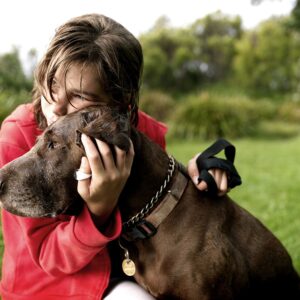 Some pets die of old age in the comfort of their own home, but many others become seriously ill or get injured in a way or experience that significantly diminishes their quality of life as they grow very old. In these situations, owners are often forced to consider the hard choice of whether to have your pet euthanized in order to spare your pet from pain and suffering.
Some pets die of old age in the comfort of their own home, but many others become seriously ill or get injured in a way or experience that significantly diminishes their quality of life as they grow very old. In these situations, owners are often forced to consider the hard choice of whether to have your pet euthanized in order to spare your pet from pain and suffering.
To know when it is time, it is important to talk with your veterinarian. They are the best-qualified person to help guide you through this difficult process. In some cases, your veterinarian may be able to tell you definitively that it is time to euthanize your pet, but in other cases, you may ultimately need to make the decision based on your observances of your pet’s behavior and attitude.
Some signs that your pet is suffering and no longer enjoying a good quality of life include chronic pain being experienced that cannot be controlled with medication, frequent vomiting or diarrhea that is causing dehydration and/or weight loss, they stop eating, incontinence, lost interest in favorite activities, cannot stand on their own, and/or chronic labored breathing. It is a very difficult decision, but one must consider your pet’s quality of life.
Once you have made the very difficult decision, you also need to decide how and where you and your family will say the final goodbye. Before the procedure is scheduled to take place, make sure that all members of your family have had time with the pet to say a private goodbye. If you have children, make sure that you explain the decision to them and prepare them for the loss of the pet in advance. This may be your child’s first experience with death, and it is very important for you to help her or him through the grieving process. Books that address the subject, such as When a Pet Dies by Fred Rogers or Remembering My Pet by Machama Liss-Levinson and Molly Phinney Baskette, may be very beneficial in helping your child to deal with this loss. It is an individual decision whether or not you and your family want to be present during the euthanasia procedure. For some pet owners, the emotion may be too overwhelming, but for many, it is a comfort to be with their pet during the final moments. It may be inappropriate for young children to witness the procedure since they are not yet able to understand death and may also not understand that they need to remain still and quiet.
Deciding when it is time to say goodbye to your pet is never easy. Owners are put into the difficult decision of deciding when it is their time. While it is never easy, the staff at Olsen Veterinary Clinic are always here to answer whatever questions you may have. Feel free to reach out at 618-656-5868 with any questions or concerns you may have!
